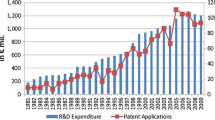Abstract
The relationship between investments in research and development (R&D) and innovative behavior, measured in terms of new products or services being delivered to the market, is well documented in the literature. This paper departs from the extant literature in that the unit of observation is a country rather than a firm. Using World Bank aggregate data, this level of analysis thus allows for a systematic study of cross-country observations on an R&D ➔ Innovation relationship.
Similar content being viewed by others
Notes
See https://www.enterprisesurveys.org/en/about-us (accessed October 14, 2020). The aggregated country statistics are based on a stratified random sample of firms within the country.
Forty-three (43) country reports present aggregated information on the R&D and innovation variables relevant to this study, but 3 of those reports do not contain information on a key independent variable and thus they are dropped from the analyses that follow.
Schumpeter (1939, p. 62) defined innovation with reference to the production process which “describes the way in which quantity of product varies if quantities of factors vary. If instead of quantities of factors, we vary the form of the function, we have an innovation.”
The World Bank uses the word enterprise when referring to these studies although the survey questions use the word firm.
“Since there is no established convention for the designation of “developed” and “developing” countries or areas in the United Nations system, this distinction is made for the purposes of statistical analysis only.” See United Nations (2005, p. 43). “In the World Development Indicators database (and most other time series datasets), all 189 World Bank member countries, plus 28 other economies with populations of more than 30,000, are classified so that data users can aggregate, group, and compare statistical data of interest, and for the presentation of key statistics. The main classifications provided are by geographic region, by income group, and by the operational lending categories of the World Bank Group.” See https://datahelpdesk.worldbank.org/knowledgebase/articles/378834-how-does-the-world-bank-classify-countries (accessed October 15, 2020).
In cross-firm studies one might also control for the industry(ies) in which the firm produces. While it would be useful to have had data from the World Bank on the major industry or industries in which firms produce, such information is not available in the country reports. See Goel (1990).
Some country-specific technology studies have been done using the World Bank’s data. See https://www.enterprisesurveys.org/en/enterprise-research (accessed October 16, 2020).
References
Audretsch, D. B., & Link, A. N. (2018a). Innovation Capital. Journal of Technology Transfer, 43, 1760–1767.
Audretsch, D. B., & Link, A. N. (2018b). Sources of knowledge and entrepreneurial behavior. Toronto: University of Toronto Press.
Audretsch, D. B., Link, A. N., & Wright, M. (2019). Disciplinary perspectives on innovation. Foundations and Trends in Entrepreneurship, 15, 1–172.
Barasa, L., Knoben, J., Vermeulen, P., Kimuyu, P., & Kinyanjui, B. (2017). Institutions, resources and innovation in East Africa: A firm level approach. Research Policy, 46, 280–291.
Bednar, S., Gicheva, D., & Link, A. N. (2019). Innovative activity and gender dynamics. Small Business Economics. https://doi.org/10.1007/s11187-019-00282-2.
Boles, J., & Link, A. N. (2017). On the R&D/marketing Interface in knowledge intensive entrepreneurial firms. International Entrepreneurship and Management Journal, 13, 943–952.
Goel, R. K. (1990). The substitutability of capital, labor, and R&D in manufacturing. Bulletin of Economic Research, 42, 211–227.
Goel, R. K., & Nelson, M. A. (2018). Determinants of process innovation introductions: Evidence from 115 developing countries. Managerial and Decision Economics, 39, 515–525.
Gicheva, D., & Link, A. N. (2016). On the economic performance of nascent entrepreneurs. European Economic Review, 86, 109–117.
Link, Albert N. (2020). Invention, innovation, and U.S. Federal Laboratories, Northampton, MA: Edward Elgar.
Link, Albert N. and James A. Cunningham (forthcoming). Advanced Introduction to Technology Policy, Northampton, MA: Edward Elgar.
Link, A. N., Morris, C. A., & van Hasselt, M. (2020). The impact of the third sector of R&D on the innovative performance of entrepreneurial firms. Small Business Economics. https://doi.org/10.1007/s11187-020-00354-8.
Link, A. N., & Ruhm, C. J. (2009). Bringing science to market: Commercializing from NIH SBIR awards. Economics of Innovation and New Technology, 18, 381–402.
Link, A. N., & Scott, J. T. (2009). Private investor participation and commercialization rates for government-sponsored Research and Development: Would a prediction market improve the performance of the SBIR Programme? Economica, 76, 264–281.
Link, A. N., & Scott, J. T. (2010). Government as entrepreneur: Evaluating the commercialization success of SBIR projects. Research Policy, 39, 589–601.
Protogerou, A., Caloghirou, Y., & Vonortas, N. S. (2017). Determinants of young firms’ innovative performance: Empirical evidence from Europe. Research Policy, 46, 1312–1326.
Schumpeter, J. A. (1939). Business cycles. New York: McGraw Hill.
Sharma, C. (2019). Effects of R&D and foreign technology transfer on productivity and innovation: An enterprises-level evidence from Bangladesh. Asian Journal of Technology Innovation, 27, 46–70.
United Nations. (2005). The millennium development goals report. New York: United Nations.
United Nations. (2020). World economic situation and prospects. New York: United Nations.
Author information
Authors and Affiliations
Corresponding author
Additional information
Publisher’s note
Springer Nature remains neutral with regard to jurisdictional claims in published maps and institutional affiliations.
An investment in knowledge pays the best interest.
—Benjamin Franklin
Rights and permissions
About this article
Cite this article
Link, A.N. Investments in R&D and innovative behavior: an exploratory cross-country study. Int Entrep Manag J 17, 731–739 (2021). https://doi.org/10.1007/s11365-020-00703-9
Accepted:
Published:
Issue Date:
DOI: https://doi.org/10.1007/s11365-020-00703-9




